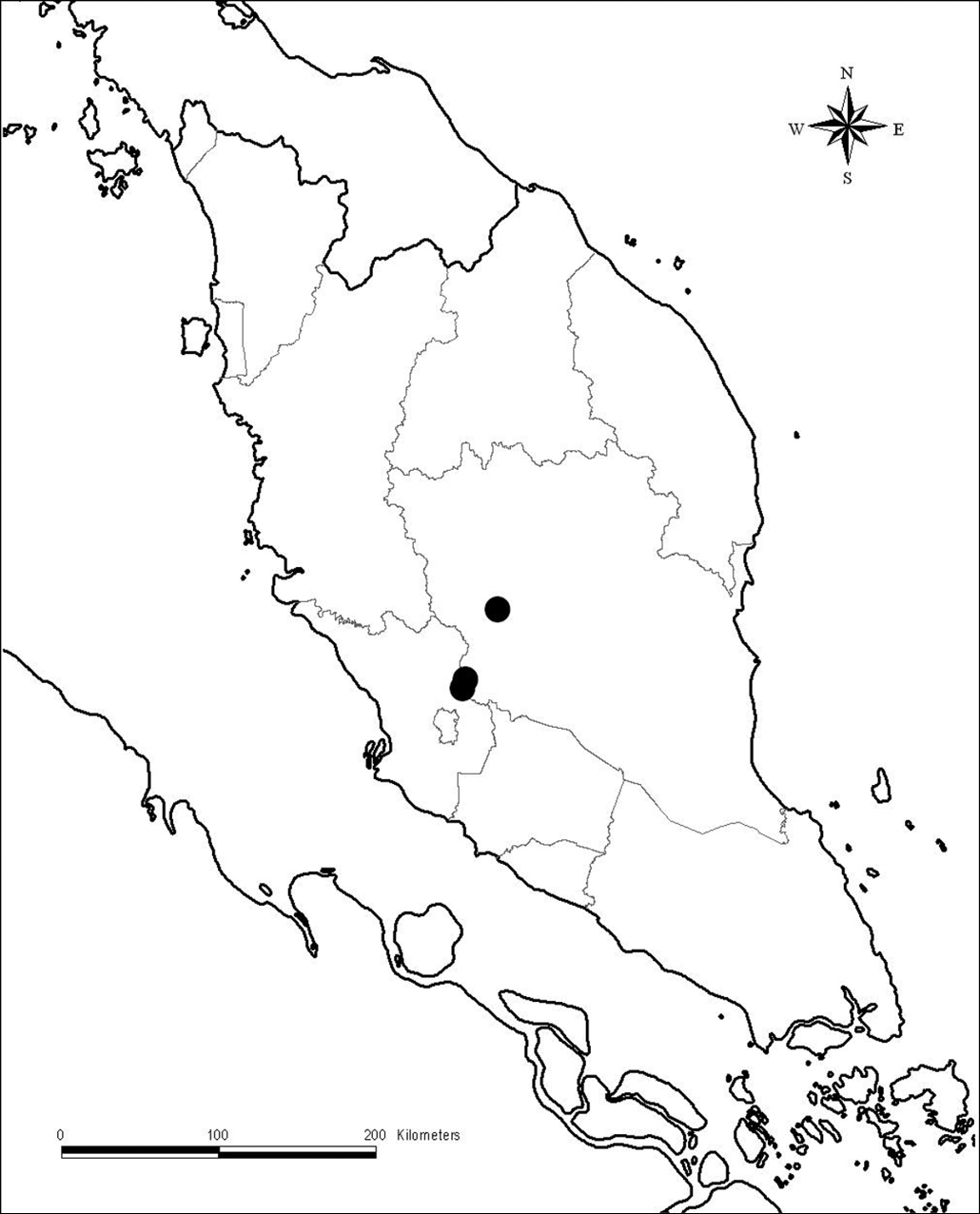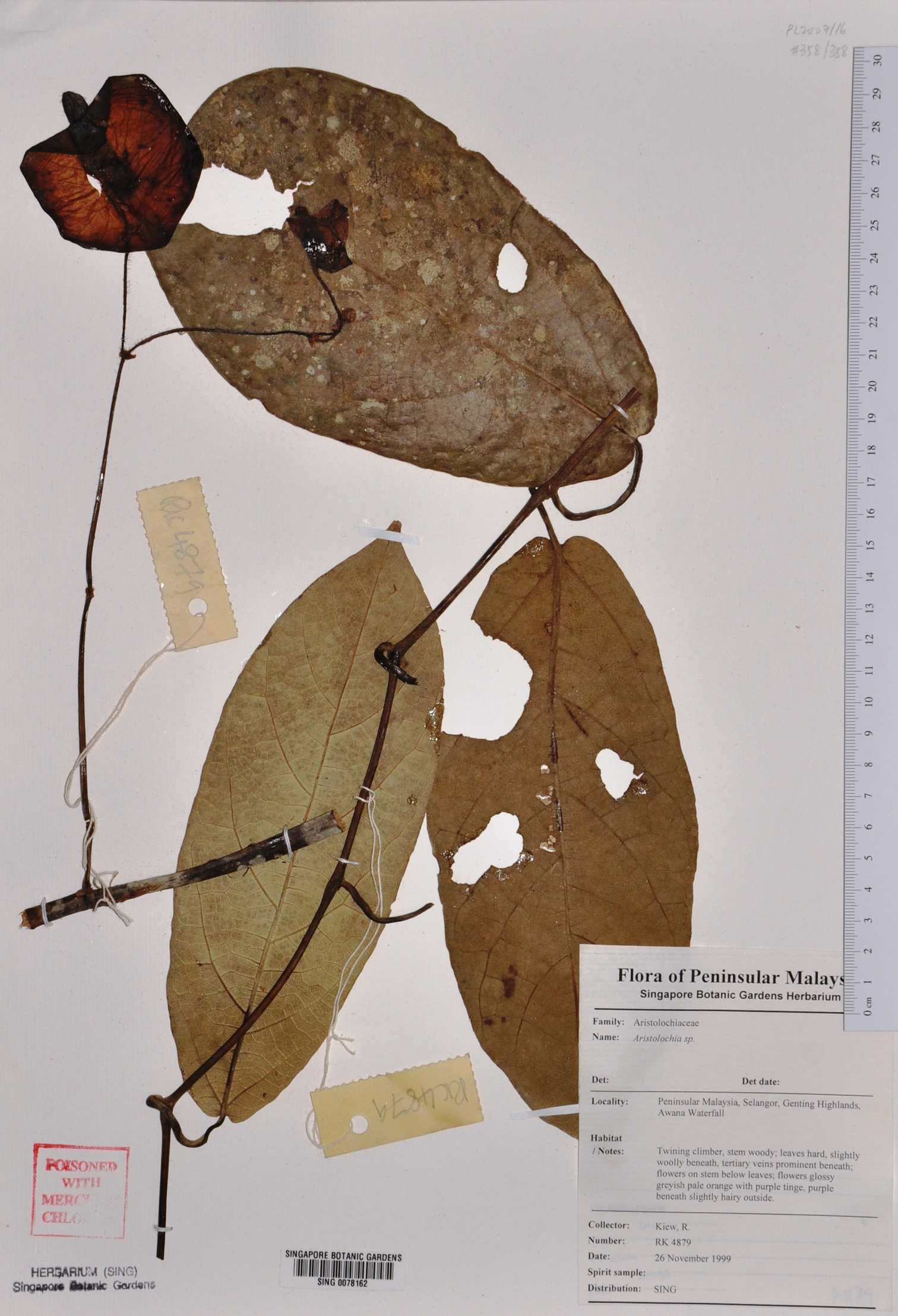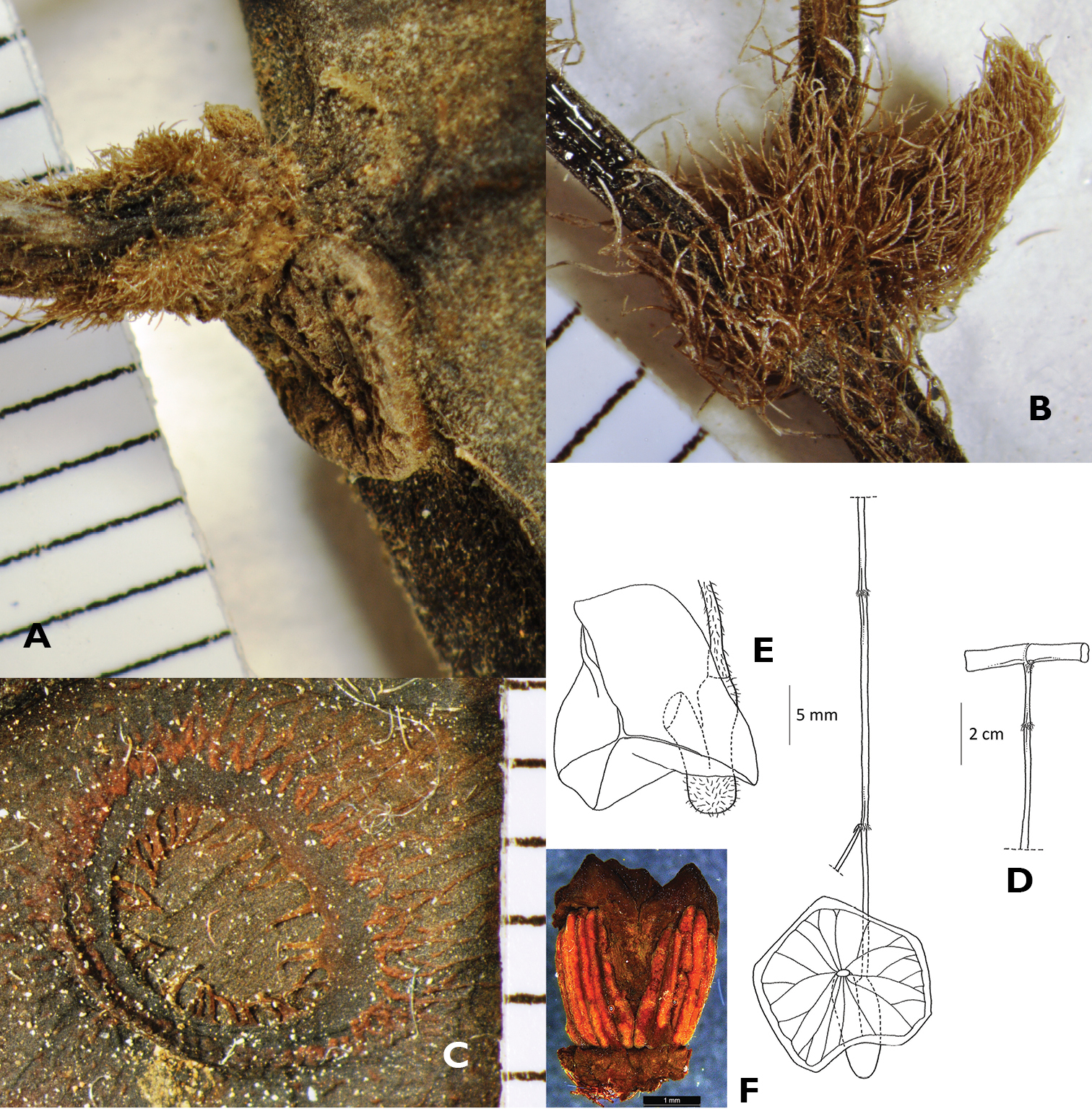






(C) 2012 Tze Leong Yao. This is an open access article distributed under the terms of the Creative Commons Attribution License 3.0 (CC-BY), which permits unrestricted use, distribution, and reproduction in any medium, provided the original author and source are credited.
For reference, use of the paginated PDF or printed version of this article is recommended.
A new species in the genus Aristolochia (Aristolochiaceae), Aristolochia vallisicola T.L.Yao, from Peninsular Malaysia is described and illustrated. Among all Peninsular Malaysian Aristolochia, itis the only species with a pinnately veined lamina and a disc-liked perianth limb. A distribution map is provided and its conservation status is assessed as Least Concern.
Aristolochiaceae, Aristolochia, Peninsular Malaysia
Aristolochia, the largest genus in the family, consists of about 400 species. It is widely distributed throughout tropics and subtropics, but also in the warm temperate regions.
The new species presented here was first collected by a Forest Guard, Kalong (KEP) in 1929 (FMS 24048) from Ulu Kelau, Pahang. The specimen consists of two detached leaves and a detached inflorescence mounted on one sheet. Its vernacular name, Akar telinga berok (the pig-tail macaque’s ear climber in Malay) indicates that it is a climber. After a lag of 70 years, Kiew collected a flowering specimen (RK 4879) in the Awana waterfall area, Genting Highlands, Pahang. The specimen is complemented by good field notes and was identified as Aristolochia sp.
Recently, I was asked to identify a leaf (Kiew s.n., barcode KEP196081) of a butterfly larva food plant collected in the Genting Tea Estate, Pahang. This instigated me to make a visit to the estate, which revealed that the plant is conspecific with the two specimens mentioned above. According to H.S. Barlow and S.K.L. Hok (pers. comm.), larvae of the butterfly species, Parides (Atrophaneura) sycorax egertoni (Distant) a member of the family Papilionidae, commonly known as the White Head Batwing (Malay name: Kepala Putih) feed on the leaves of this species. Their observations in the Genting Tea Estate revealed that its larvaedefoliate young plants and then girdle the stem base just before they metamorphose into pupae. The plant manages to re-sprout later.
Taxonomyurn:lsid:ipni.org:names:77120982-1
http://species-id.net/wiki/Aristolochia_vallisicola
Figures 1 – 3This species differs from all other Peninsular Malaysian Aristolochia L. species in its lamina with pinnate lateral veins, inflorescence with a long peduncle, its disc-shaped perianth limb, annulated hairy perianth mouth and 3-lobed gynostemium. This species is similar to Aristolochia coadunata Backer in the lanceolate or oblanceolate lamina with pinnate lateral veins but differs in its larger disc-shaped perianth limb, 58–65 mm diam. versus 15–30 mm diam. in Aristolochia coadunata and its longer peduncle, 15.5–17 cm long versus up to 2 cm long in Aristolochia coadunata. This species is also similar to Aristolochia versicolor S.M.Huang in the lanceolate or oblanceolate lamina with pinnate lateral veins but differs in its longer petiole, 2.5–7 cm long versus 1–2 cm long, broader leaves, at least 7.5 cm wide versus to 6.5 cm wide, and longer peduncle, 15.5–17 cm long versus 2–3(–10) cm long in Aristolochia versicolor. The summary and other characters comparison is presented in Table 1.
Type. Peninsular Malaysia. Pahang: Genting Highlands, Awana Waterfall. 26 November 1999 (fl), R.Kiew 4879 (holotype SING!, barcode 78162).
Comparison of Aristolochia vallisicola, Aristolochia coadunata and Aristolochia versicolor.
| Characters | Aristolochia vallisicola | *Aristolochia coadunata | **Aristolochia versicolor (China) | ***Aristolochia versicolor (Thailand) |
|---|---|---|---|---|
| Petiole length; indumentum | 2.5–7 cm long; puberulous | 3–9 cm long; pubescent | 1–2 cm long; sparsely pilose | 1–2 cm long; adpressed hairy |
| Lamina; length by width (cm) | lanceolate, oblanceolate or broadly oblanceolate; 15–24 × 7.5–14 | ovate oblong to lanceolate, rarely ovate; 7.5–33 × 4–12 | narrowly elliptic to lanceolate-elliptic; 14–25 × 4–6.5 | oblanceolate, oblong-oblanceolate, or elliptic oblong; 11.2–17.5 × 3.4–4.7 |
| Lamina base; sinus depth (mm) | cordate; 2–3 | cordate; 5–10 | narrowly auriculate; 5–7 | narrowly, slightly cordate |
| Pinnate lateral vein pairs | 6–7 | 4–6 | 9–10 | 7–8 |
| Inflorescence | cauline; peduncle 15.5–17 cm long, divided into 4–5 internodes of different lengths | in axils of foliage leaves, rarely cauline; peduncle up to 2 cm long | in axils of foliage leaves, peduncle 2–3 cm long | in axils of foliage leaves, peduncle ca 10 cm long |
| Bract indumentum | pilose | puberulous | — | pilose |
| Perianth | tube geniculately curved, utricle cylindric, ca 30 × 8 mm, tube ca 35 × 8 mm; limb disc-shaped, 58–65 mm diam., 3-lobed, mouth annulate | tube geniculately curved, utricle ovoid tubular, 35–30 × 7 mm, tube cylindric, 30–45 × 6 mm, limb disc-shaped, 15–30 mm diam., obscurely 3-lobed, mouth not annulate | tube geniculately curved, basal portion of tube 30–40 × 6–8 mm; limb disc-shaped, 40–60 mm diam., 3-lobed, mouth annulate | tube geniculately curved, utricle ovoid, 8–10 × 8–12 mm, tube ca 13–23 × 5–7 mm; limb disc-shaped, 46–50 mm diam. |
| Distribution | Peninsular Malaysia | Sumatra, Java, †Peninsular Malaysia ( |
China: Guangdong, Guangxi, Yunnan ( |
North Eastern Thailand ( |
* Images of Backer 26130 (L), Bosscha s.n.(BO-108722) (BO), Schouten s.n. (BO-108723 & BO-108735) (BO), van Steenis 4317, 7326, 12625 (L) seen. Comparison also based on species description and drawings (
** Type specimen could not be located. Comparison based on species description and line drawings (
*** Comparison based on images of Beusekom and Phengklai 2985 (L) and its line drawing, and species description (
† Igarashi and Fukuda (1997) recognised Aristolochia coadunata as occurring in Peninsular Malaysia and mentioned that it is one of the food plants of Parides (Atrophaneura) sycorax. I have not seen any Aristolochia coadunata specimens from Peninsular Malaysia.
Slender climber. Stem ca 2.5 mm thick, surface shallowly furrowed, sometimes smooth, puberulent, trichomes hooked. Leaves: petiole twisted, 2.5–7 cm long, ca 2.5 mm thick, puberulent, indumentum a mix of hooked and straight hairs; lamina lanceolate or narrowly oblanceolate or oblanceolate, 15–24 × 7.5–14 cm; base cordate, auricles rounded, sinus 2–3 mm deep, 8–12 mm wide, margin entire, apex acute; leathery; lamina surface above glabrescent, with scattered black gland dots, lamina surface below puberulent, indumentum a mix of longer straight and shorter hooked hairs; midrib above sunken, below prominent; lateral veins pinnate, above faint, below prominent, basal pair 1, pinnate pairs 5–7; intercostal veins net-like. Inflorescences cauline, solitary; peduncle branched once; 15.5–17 cm long, ca 2 mm thick, puberulent, indumentum mainly of hooked trichomes, scattered with long spreading hairs. Bracts ovate, ca 3 × 1.5 mm, pubescence, base cuneate, apex acute. Flowers: pedicel ca 40 mm long, ovary ca 13 × 2 mm, villous; perianth glossy, greyish pale orange with purple tinge, purple beneath, ca 6.5 cm long, outer surface sparsely villose with shorter hooked trichomes, tube geniculately curved, utricle cylindric, ca 30 × 8 mm, inner surface with a glistening white patch of stellate trichomes, perianth tube ca 35 × 8 mm, limb disc-shaped, 5.8–6.5 cm diam., 3-lobed, venation faint, mouth annulate, villous; gynostemium in transverse section faintly trigonal; stamens 6, anthers ca 3 × 0.3 mm; stigmatic lobes 3, conical, ca 0.8 mm long, apex blunt. Fruit and seed unknown.
Distribution of Aristolochia vallisicola (●).
Type specimen of Aristolochia vallisicola (Kiew RK 4879, SING, barcode 78162).
Aristolochia vallisicola T.L. Yao, A insertion of an inflorescence in axil of petiole scar at thickened stem node B villous inflorescence bract C annulated perianth mouth D an inflorescence with an opened flower E flower bud F gynostemium. (All from Kiew RK 4879.)
Akar telinga berok (Malay).
Aristolochia vallisicola isendemic in Peninsular Malaysia, Pahang. It has only been found on Titiwangsa Range and its vicinities.
Thisspecies occurs in highland valleys of lower montane forest about 1000 m altitude and often by rocky streamsides. Specimens with flowers werecollected in September and November.
The species name vallisicola denotes its habitat preference for valleys.
Least Concern. This species occurs above 1000 m altitude, a habitat which is protected by Malaysian legislation.
Peninsular Malaysia, Pahang: Ulu Kelau, Raub, 24 September 1929 (fl), Kalong FMS 20248 (KEP, barcode 196080); Genting Tea Estate, R. Kiew s.n. (KEP, barcode 196081).
Aristolochia vallisicola with disk-shaped perianth of 3 lobes which valvate in bud, annulated perianth mouth and gynostemium with 3 segments each consisting 2 stamens belongs to Isotrema (
Old World Aristolochia species with a disc-shaped perianth limb are common in northern India (
Speciesof Aristolochia, a genus of high climber or woody lianas in Malesian forests, are not easy sighted and are very often represented by meagre herbarium specimens. Furthermore, the plants are rarely found in flower. In the past 15 years, 8 new species of Aristolochia were described from Thailand (
This study is part of the revision of Aristolochiaceae for the Flora of Peninsular Malaysia Project (01-04-01-0000 Khas) and Documentation & Inventory Flora of Malaysia Project based at Forest Research Institute Malaysia and fully funded by the Ministry of Science, Technology and Innovation, Malaysia and 10th Malaysian Plan, respectively. The keeper and manager of the SING herbarium are gratefully acknowledged for allowing me to loan and examine specimens under their care. I am grateful to L.G. Saw, R.C.K. Chung, R. Kiew (all KEP) and the anonymous reviewer for their constructive advice and comments on the manuscript. I thank H.S. Barlow for his hospitality during my visit to Genting Tea Estate and S.K.L. Hok for guiding me to observe the living plant within the estate. I am grateful to C.K. Phon (FRIM) and P. Wilkie (E) for providing me with obscure literature and to B.E.E. Duyfjes (L) and K. Abdulrokhman (BO) for sending me specimen images.


